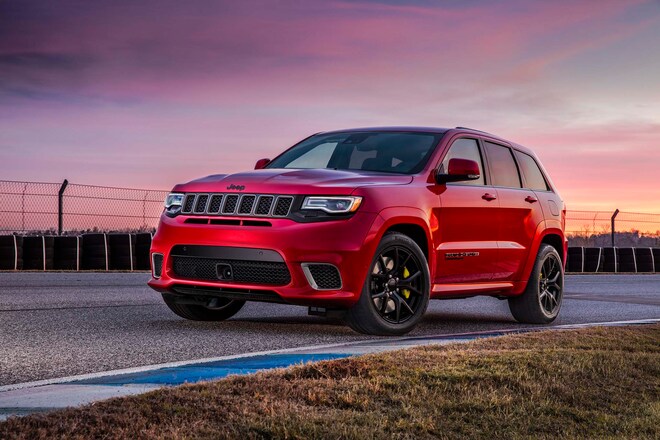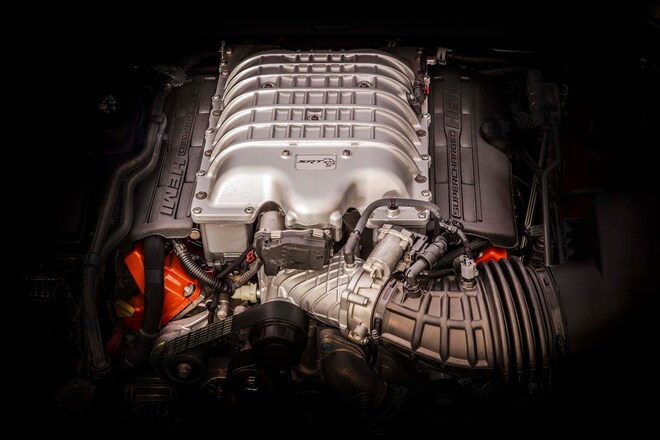Well, it’s finally here. The highly anticipated Jeep entry in the Hellcat Hall of Fame. At long last, “active lifestyle” sporty utilitarians get their very own 707-hp, 645-lb-ft conveyance in which to trebuchet their kayaks and carabiners from the city house to the country house. If you can imagine Motor Trend’s sister brand Roadkill doing a weekend engine swap of a Hellcat crate engine into a Grand Cherokee SRT8 to produce the world’s most powerful SUV, you’ve got about 90 percent of the design brief for the 2018 Jeep Grand Cherokee Trackhawk.
The engine is almost exactly the same as the one powering Challenger and Charger Hellcats, from boost pressure (11.6 psi) and max air flow rate (30,000 liters per minute) to peak in-cylinder pressures (1,600 psi). One difference: The oil capacity is slightly greater—8.3 versus 7.0 quarts. That helps it cope with the most significant difference in the Jeep’s duty cycle: the ability power all four wheels and to tow 7,200 pounds (just as the SRT8 can). The eight-speed Torqueflite transmission shares the gear ratios of the Hellcat cars but is beefed up slightly for AWD towing duty, earning the name 8HP95, up from 8HP90. Naturally, there are paddle shifters, and the normal half-second shift time can be trimmed to a quarter-second in the Sport dynamic driving mode and to just 160 milliseconds in Track mode.

The transmission bolts up to a Quadra-Trac MP 3015C single-speed transfer case that is capable of varying the front to rear torque split from 60/40 percent in trailer-towing mode to 30/70 in Track mode, with intermediate stops at 50/50 (Snow mode) and 40/60 (Automatic mode). Snow and Tow modes are new to the Jeep. (The Auto, Sport, and Track modes match those in the cars.) Oh, and the Hello Kitty Quadra-Trac gets forged steel chain sprockets pulling a wider chain for added strength and durability.
Other Jeep-specific upgrades include the use of an electronic limited-slip differential out back sporting way shorter gearing than in the cars (3.70:1 versus 2.62:1, matching the Jeep SRT8’s cogs). The housing is redesigned relative to the one in the SRT8 with revised ring-and-pinion tooth geometry and a new four-point axle mounting scheme to better distribute the enormous forces attempting to twist it away from the chassis. From there, the torque flows through halfshafts made of ultra-high-strength 300M alloy vacuum-melted steel to upgraded eight-ball outboard constant velocity joints. If you’re a metal nerd, that steel is essentially a modified AISI 4340 steel with silicon, vanadium, and slightly more carbon and molybdenum—mega tough yet ductile.

The front brakes are the biggest in the Hellcat/SRT pantheon at 15.75 inches, chomped by bright yellow six-piston Brembo calipers (up from 15.00 on the Jeep SRT8 and 15.40 on the Hellcat cars). The rears match the SRT8 and Hellcat cars at 13.78 inches with yellow four-piston calipers. Those calipers peer out from 10.0-by-20-inch wheels; cast aluminum comes standard with a titanium finish, and forged aluminum with low-gloss black finish is an option (they’re 12 pounds lighter).
Appearance-wise, most of the SRT8 bits are unchanged, except where the foglamps live in the SRT8 you’ll find air inlets in the Trackhawk; the driver-side one feeds cold air into the engine intake, the other serves an oil cooler. Out back, the dual exhausts are replaced by black chrome quad exhaust tips. Each front door gets a “Supercharged” badge, and the hatch gets a “Trackhawk” badge. Inside, there’s a 200-mph speedometer, Nappa leather and suede seats, with a fully wrapped “Signature Leather” package available. Premium genuine interior metal trim is standard, as are embroidered Berber floor mats.
On the standard 8.4-inch Uconnect touchscreen, which features Apple CarPlay and Android Auto, are exclusive Trackhawk Performance Pages to monitor and record various performance parameters. The Jeep also offers a trailer hitch camera view that enables the driver to keep an eye on a trailer while driving. There’s also a Valet mode that limits horsepower, torque, and max engine speed, locks out the transmission’s first gear, disables manual mode and paddle shifters, reverts to Street settings, puts ESC on full-on mode, and disables launch control.
So how should the Grand Cherokee Trackhawk run? Jeep’s official estimates are 0–60 mph in 3.5 seconds, the quarter mile in 11.6 seconds at 116 mph, a top speed of 180 mph, max lateral grip of 0.88 g, and 60–0-mph braking in 114 feet. For reference, our best Charger Hellcat did 3.8, 11.9 seconds at 122.8 mph, 0.92 g, and 105 feet from 60 mph, and our last Jeep SRT8—a 2012 model making 470-hp and 465-lb-ft with a five-speed auto (current versions make 475/470 and have eight speeds)—hit 60 in 4.6 seconds, the quarter in 13.3 seconds at 103.2 mph, gripped at 0.88 g, and stopped in 105 feet. Note that Jeep is claiming its baby is the world’s quickest SUV, but the track sheets from our Tesla Model X P90D (Ludicrous) suggest that’ll be one photo-finish drag race (0–60 in 3.2, 11.7 at 116.0 mph in the quarter).
There’s still no word on pricing, but applying the Charger’s SRT-to-Hellcat premium to the Jeep SRT8 suggests an opening price of around $84,500. Get your orders in now. Deliveries start in the fourth quarter of 2017.
Jason Udy contributed to this story
| 2018 Jeep Grand Cherokee Trackhawk | |
| BASE PRICE | $84,500 (est) |
| VEHICLE LAYOUT | Front-engine, AWD, 5-pass, 4-door SUV |
| ENGINE | 6.2L/707-hp/645-lb-ft supercharged OHV 16-valve V-8 |
| TRANSMISSION | 8-speed automatic |
| CURB WEIGHT | 5,350 lb (mfr) |
| WHEELBASE | 114.7 in |
| LENGTH X WIDTH X HEIGHT | 189. x 76.5 x 67.9 in |
| 0-60 MPH | 3.5 sec (mfr est) |
| EPA CITY/HWY/COMB FUEL ECON | Not yet tested |
| ON SALE IN U.S. | Fourth quarter, 2017 |
Source: MotorTrend
